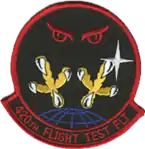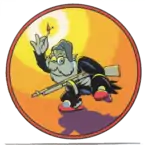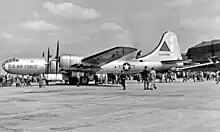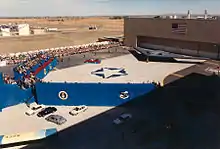420th Flight Test Flight
The 420th Flight Test Squadron is an active United States Air Force squadron.
| 420th Flight Test Squadron | |
|---|---|
 420th Flight Test Flight T-38 Talon | |
| Active | 1943–1944; 1954–1964; 1989–1997; 2001–2007; 2019-present |
| Country | |
| Branch | |
| Type | Flight |
| Role | Flight Testing |
| Part of | Air Force Reserve Command |
| Garrison/HQ | Phoenix-Mesa Gateway Airport |
| Decorations | Air Force Outstanding Unit Award[1] |
| Insignia | |
| 420th Flight Test Flight Emblem Approved 22 May 1996[1] |  |
| 420th Air Refueling Squadron Emblem (approved 20 September 1955) |  |
| 420th Night Fighter Squadron Emblem (approved 13 April 1944)[2] | _-_Emblem.png.webp) |
| 420th Night Fighter Squadron Emblem (original design) |  |
| Aircraft flown | |
| Trainer | T-38 Talon |
The squadron was first activated as the 420th Night Fighter Squadron, one of the first dedicated night fighter operational training squadrons of the Air Force. It trained replacement night fighter pilots who were then deployed overseas into combat until its inactivation in March 1944 due to a re-alignment of training unit designations.[3]
It was reactivated as the 420th Air Refueling Squadron under Tactical Air Command in 1954 and moved to England, where it served under the United States Air Forces Europe. It was inactivated when Strategic Air Command assumed the role of single manager for USAF air refueling. In 1985 the night fighter and refueling squadrons were consolidated into a single unit.
The 6520th Test Squadron was organized in 1989 by Air Force Systems Command. In 1992, as the USAF eliminated Major Command controlled (MAJCON) units, the 6520th was consolidated with the 420th and re-designated as the 420th Flight Test Squadron. The squadron was inactivated as an active-duty unit in 1997, but was activated four years later in the Air Force Reserve Command as the 420th Flight Test Flight. It was last assigned to the 413th Flight Test Group of Air Force Reserve Command at Phoenix-Mesa Gateway Airport, Arizona, where it was inactivated on 31 October 2007.
The squadron was reactivated on 4 October 2019 to support flight testing of the Northrop Grumman B-21 Raider.
History
World War II

The squadron was activated on 1 June 1943 at Orlando Army Air Base, Florida as the third night fighter training squadron of the 481st Night Fighter Operational Training Group (481 NFOTG). Its mission was to be a Replacement Training Unit (RTU) for Night Fighter pilots. It accepted Army Air Forces Training Command's twin-engine flying training and B–25 transition school graduates and trained them as night fighter pilots.[3]
The initial squadron personnel were veteran pilots of the 481 NFOTG, with some being transferred from the group's 348th and 349th Night Fighter Squadrons which performed Operational Training of new squadrons. It was initially equipped with Douglas DB-7s and Douglas P-70s.[3]
As 1943 progressed additional aircraft and equipment arrived and the program expanded. In September, the first American-built dedicated night fighter began to arrive, the Northrup YP-61 Black Widow and a few production P-61As. In January 1944 the entire program moved to Hammer Field, California and was placed under IV Fighter Command. The move placed the squadron near Northrop manufacturing facility at Hawthorne, California and most programmed P-61 squadrons were planned for operations in the Pacific and China Burma India Theaters.[3]
In March 1944 the 420th was disbanded when the AAF found that standard military units, based on relatively inflexible tables of organization were proving less well adapted to the training mission. Accordingly, a more functional system was adopted in which each base was organized into a separate numbered unit during a reorganization of units in the United States.[4] The squadron's personnel and equipment were transferred to Squadron C of the 450th Army Air Forces Base Unit (Night Fighter Replacement Training Unit).[3]
Air refueling


The 420th Air Refueling Squadron was activated in 1954 by Tactical Air Command to provide dedicated air refueling for TAC bombers, fighters, and fighter bombers. The 420th was activated at Alexandria Air Force Base, Louisiana and was the first TAC air refueling squadron. The squadron received KB-29Ps fitted with the refueling boom.[5]
In 1955 the unit deployed to United States Air Forces in Europe and was based at RAF Sculthorpe, Norfolk, England to provide air refueling for USAFE squadrons. However, the KB-29s were simply too slow to refuel jet fighters. The increasing performance of operational fighters made it necessary to boost the performance of the tankers, and this was done by re-equipping with the KB-50 Superfortress starting in December 1956[5] which provided greater speed to refuel jet aircraft. The squadron received its first KB-50J in 1958.[5] This model added a J-47 turbojet engine underneath each wing in place of the auxiliary fuel tanks to increase the speed of the aircraft. The KB-29P was phased out in 1959.[5]
Unfortunately, the elderly KB-50Js began to deteriorate almost as soon as they were delivered, and due to a chronic parts shortage TAC was forced to resort to cannibalization to keep the retrofitted tanker aircraft flying. Landing gear malfunctions were frequent, and many parts started to break simply because of old age. More and more maintenance had to be performed in order to keep the aircraft flying.[6]
With the 47th Bombardment Wing's inactivation the 420th ARS at Sculthorpe was assigned to the 7375th Combat Support Group, a temporary unit at Sculthorpe after its turnover to the Air Ministry. On 1 September 1963 it was reassigned directly to Third Air Force.
By 1963 the squadron's aircraft began to be phased out, the mission being taken over primarily by Air National Guard Boeing KC-97 Stratofreighters. rotating to Europe under Operation Creek Party. The squadron inactivated in early 1964[5] and its KB-50Js were sent to the Military Aircraft Storage and Disposition Center at Davis–Monthan Air Force Base. Arizona.
B-2 Spirit Flight Testing
Air Force Systems Command activated the 6520th Test Squadron in March 1989 at Edwards Air Force Base, California. Its mission was the pre-operational testing of the B-2 Spirit stealth bomber. The B-2 was first revealed to the public on 22 November 1988, when AV-1 (82-1066 "Spirit of America") was unveiled at Air Force Plant 42 near Palmdale, California. At this time the aircraft was still not ready for its first flight. Taxi tests began on 10 July 1989. The B-2 finally made its first flight on 17 July 1989 from Palmdale. The flight lasted 112 minutes and ended with a landing at Edwards and delivery to the 6520th.[7]

After carrying out initial tests, AV-1 was used for radar cross section tests. In early 1993, AV-1 was placed in long term storage to await upgrading to full service configuration prior to joining the operational fleet. The second test aircraft (AV-2, 82–1067 "Spirit of Arizona") flew for the first time on 19 October 1990 from Palmdale, landing at Edwards AFB. It was heavily instrumented and served as the loads test aircraft.[7]
AV-3 (82-1068 "Spirit of New York") took to the air for the first time on 18 June 1991. It was the first radar and navigation test aircraft. AV-4 (82-1069 "Spirit of Indiana") followed on 17 April 1992, and AV-5 (82-1070 "Spirit of Ohio") on 5 October 1992. These two planes were used for avionics and weapons testing. The first bomb to be tested with the B-2 was a 2000-lb Mk 84, which was dropped from AV-4 on 12 September 1992. AV-5 was the intended for armament, climatic, and low-observability testing.[7]
On 1 October 1992, the 6520th Test Squadron was consolidated with the 420th Air Refueling Squadron. The next day the consolidated unit was renamed the 420th Test Squadron.[1]
The last development aircraft, AV-6 (82-1071 "Spirit of Mississippi") flew on 2 February 1993. It was used for technical order validation and for further weapons and avionics testing.[7][8] By January 1995 the six B-2s had logged more than 2300 hours in the air in more than 490 flights. Terrain-following certification flights were undertaken by AV-4 in September 1996. By January 1997, the B-2 had reached limited operational capability and testing at Edwards was phased down. B-2 flight testing was transferred to the 419th Flight Test Squadron and the squadron was inactivated at the end of 1997.
T-38 Talon Flight Testing
The 420th was reactivated in 2001 at Phoenix–Mesa Gateway Airport, Arizona (formerly Williams Air Force Base) as the 420th Flight Test Flight. The flight acted as a Northrop T-38 Talon functional check flight organization. The 420th replaced Operating Location E of the 622d Regional Support Group, which originally stood up in May 2000. After the 413th Flight Test Group was created at Robins Air Force Base, Georgia, the flight was reassigned to the group in 2003.[1][9]
The unit supported Boeing's modification of the T-38C trainer's flight, engine and navigational avionics and the addition of a heads-up display, inertial navigation system, and a flight recorder. The 420th flew depot-level test sorties and acceptance check flights after the upgrades were completed. In addition, pilots brought Talons to Mesa for upgrade and then delivered them to flying units after the work was complete. The squadron was inactivated on 31 October 2007 when the cockpit upgrade program was completed.[9]
B-21 Raider Flight Testing
In September 2019 it was reported that the squadron would be reactivated to support flight testing of the Northrop Grumman B-21 Raider, reprising a similar role it performed in the development of the B-2.[10] The squadron was reactivated on 4 October 2019.[11]
Lineage
420th Night Fighter Squadron
- Constituted as the 420th Night Fighter Squadron on 25 May 1943
- Activated on 1 June 1943
- Disbanded on 31 March 1944
- Reconstituted and consolidated with the 420th Air Refueling Squadron on 19 September 1985[1]
420th Air Refueling Squadron
- Constituted as the 420th Air Refueling Squadron, Fighter-Bomber on 8 December 1953
- Activated on 18 March 1954
- Redesignated 420th Air Refueling Squadron, Tactical on 8 August 1958
- Discontinued and inactivated on 25 March 1964
- Consolidated with the 420th Night Fighter Squadron on 19 September 1985 as the 420th Air Refueling Squadron, Heavy
- Consolidated with the 6520th Test Squadron on 1 October 1992[1]
420th Flight Test Flight
- Designated as the 6520th Test Squadron and activated on 10 March 1989
- Consolidated with the 420th Air Refueling Squadron on 1 October 1992
- Redesignated 420th Test Squadron on 2 October 1992
- Redesignated 420th Flight Test Squadron on 1 March 1994
- Inactivated on 30 December 1997
- Redesignated 420th Flight Test Flight on 24 September 2001
- Redesignated 420th Flight Test Squadron in 2019
- Activated on 4 October 2019
Assignments
- Air Defense Department, Army Air Forces School of Applied Tactics, 1 June 1943 (attached to 481st Night Fighter Operational Training Group after 17 July 1943)
- 481st Night Fighter Operational Training Group, 26 July 1943 – 31 March 1944
- Ninth Air Force, 18 March 1954 (attached to 366th Fighter-Bomber Wing until 22 September 1955)
- Third Air Force, 9 October 1955 (attached to 47th Bombardment Wing after 15 March 1960)
- Seventeenth Air Force, 1 July 1961 (remained attached to 47th Bombardment Wing)
- 47th Bombardment Wing, 8 November 1961
- Seventeenth Air Force, 22 June 1962 (attached to 7375th Combat Support Group after c. June 1962)
- 7375th Combat Support Group, 1 October 1962 – 25 March 1964
- 6510th Test Group (later 412th Test Group), 10 March 1989 – 30 December 1997
- 622d Regional Support Group, 1 October 2001
- 413th Flight Test Group, 1 October 2003 – 31 October 2007[1][9]
Stations
|
|
Aircraft
|
|
Awards
| Award streamer | Award | Dates | Notes |
|---|---|---|---|
| Air Force Outstanding Unit Award | 1 January 1995 – 31 December 1995 | 420th Flight Test Squadron[1] | |
| Air Force Outstanding Unit Award | 1 January 1996 – 31 December 1996 | 420th Flight Test Squadron[1] | |
| Air Force Outstanding Unit Award | 1 January 1997 – 30 December 1997 | 420th Flight Test Squadron[1] |
See also
References
Notes
- Butler, William M. (18 December 2007). "Factsheet 420th Flight Test Flight (AFRC)". Air Force Historical Research Agency. Retrieved 8 January 2019.
- Maurer, Combat Squadrons, p. 516
- Pape, Campbell & Campbell,
- Goss, p. 75
- Bessette, John F. (20 April 2007). "Tactical Tankers: KB-29/KB-50, 1953–1965: A Chronology" (PDF). Tac Tankers Association. Retrieved 10 July 2017.
- Knaack,
- Baugher, Joe (27 September 2015). "Northrop B-2A Spirit". joebaugher.com. Retrieved 10 July 2017.
- "USAF Serial Number Search Results: Northrop B-2". joebaugher.com. 15 March 2009. Retrieved 11 July 2009.
- Wilson, SSG Celena (18 September 2007). "Round the Reserve: Flight test unit closes its doors". Citizen Airman. Retrieved 8 July 2017.
- "Northrop Grumman B-21 Raider first flight route announced". Flight Global. 17 September 2019. Retrieved 18 September 2019.
- "420th Flight Test Squadron reactivated to support B-21 Raider testing at Edwards". Edwards Air Force Base. 4 October 2019.
Bibliography
![]() This article incorporates public domain material from the Air Force Historical Research Agency.
This article incorporates public domain material from the Air Force Historical Research Agency.
- Goss, William A (1955). "The Organization and its Responsibilities, Chapter 2 The AAF". In Craven, Wesley F; Cate, James L (eds.). The Army Air Forces in World War II. Vol. VI, Men & Planes. Chicago, Illinois: University of Chicago Press. LCCN 48-3657.
- Knaack, Marcelle Size (1978). Encyclopedia of US Air Force Aircraft and Missile Systems (PDF). Vol. 2, Post-World War II Bombers 1945–1973. Washington, DC: Office of Air Force History. ISBN 0-912799-59-5. Retrieved 17 December 2016.
- Maurer, Maurer, ed. (1982) [1969]. Combat Squadrons of the Air Force, World War II (PDF) (reprint ed.). Washington, DC: Office of Air Force History. ISBN 0-405-12194-6. LCCN 70605402. OCLC 72556. Retrieved 17 December 2016.
- Pape, Garry R., John M. and Donna Campbell. (1991) Northrop P-61 Black Widow: The Complete History and Combat Record. St. Paul, Minnesota: Motorbooks International, ISBN 0-87938-509-X

